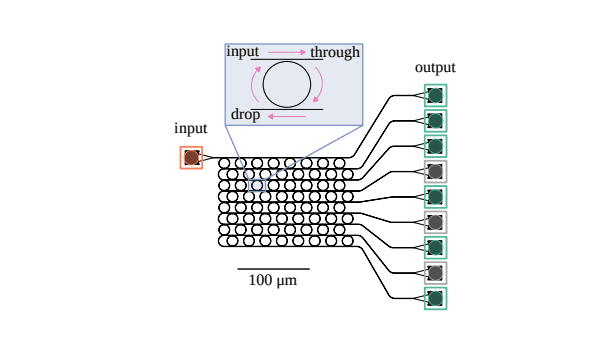Neuromorphic computing promises substantial gains in energy efficiency and processing speed, yet struggles to incorporate the complex nonlinearities and long-term memory essential for advanced tasks. Alessandro Foradori, Alessio Lugnan, Lorenzo Pavesi, and Peter Bienstman, from Ghent University-imec and University of Trento, address this challenge by developing silicon photonic circuits that mimic the brain’s structure and function. Their innovative system utilises networks of microscopic ring resonators to create a compact and powerful platform for processing information, simultaneously exploiting spatial, temporal, and wavelength dimensions. The team demonstrates the effectiveness of this approach on standard image classification tasks, achieving significantly improved accuracy without relying on traditional digital memory, and paving the way for more efficient and versatile machine learning systems.
Photonic Neural Networks for Faster Computing
Scientists are developing photonic neuromorphic computing systems, which use light instead of electronics to build artificial neural networks. This approach promises faster computation, greater energy efficiency, and increased parallelism. Researchers are building these systems using integrated silicon photonics, fabricating optical components on silicon chips similar to how electronic circuits are made. Central to this work are microresonators, tiny circular waveguides that trap light and create resonant modes. By tuning these resonators, scientists can control light and implement functions crucial for neural networks.
Researchers are exploring self-pulsing microresonators, which mimic the spiking behavior of biological neurons, and utilizing phase change materials to enable non-volatile memory and tunable optical elements. Waveguides guide light around the chip, connecting these components. The research explores building photonic neural networks using reservoir computing, where a fixed, randomly connected network of nodes processes input signals, and spiking neural networks, which mimic biological neurons using spikes. A key focus is building passive photonic neural networks, which do not require active components, leading to lower power consumption and increased reliability.
Phase change materials allow for non-volatile storage of network weights, allowing the network to retain knowledge even when powered off. Scientists fabricate and characterize integrated photonic circuits by designing the layout of waveguides, resonators, and other components on silicon chips. They use nanofabrication techniques like lithography and etching to create these circuits and then measure their optical properties to validate theoretical models and evaluate circuit performance. Researchers are evaluating their photonic neural networks on standard machine learning tasks, including MNIST handwritten digit recognition and Fashion-MNIST, demonstrating the potential of photonic systems for image classification and pattern recognition.
This work demonstrates that microresonators can effectively function as nodes in reservoir computing systems and are well-suited for implementing spiking neural networks. The passive nature of the photonic networks leads to lower power consumption, and the use of phase change materials allows for non-volatile storage of network weights. Successful fabrication and characterization of integrated photonic circuits represent a significant achievement. Future research will focus on scaling up these systems to build larger and more complex photonic neural networks, dynamically tuning photonic devices, and integrating them with electronic circuits to create hybrid systems.
Optimizing network architecture and investigating new materials for photonic devices are also key areas of focus. This research, led by A. Foradori, A. Lugnan, P. Bienstman, and L. Pavesi, represents a significant step towards building energy-efficient and high-performance photonic neural networks with promise for image recognition, pattern classification, and artificial intelligence.
Silicon Microring Network for Neuromorphic Computing
Scientists engineered a silicon microring resonator (MRR) network to overcome limitations in power efficiency and scalability often found in neuromorphic computing systems. This system exploits spatial, temporal, and wavelength dimensions within an integrated circuit to enhance machine learning performance. The system consists of an 8×8 matrix of 64 coupled MRRs, connected by waveguides and terminated by grating couplers that serve as input and output ports. The team designed MRRs with relatively low quality factors to ensure spectral overlap and coupling between different rings, mitigating the impact of fabrication tolerances and variations in resonant frequency.
Each MRR acts as a filter, selectively redirecting light depending on how closely the input optical frequency matches its resonant frequency. Scientists stabilized the chip temperature using a Peltier cell to precisely control resonant frequencies. Experiments employed a constant input signal to demonstrate how the MRR network responds to changes in optical power and frequency. Sufficiently high input power temporarily alters the resonance frequency of each MRR via silicon nonlinear effects, impacting free carrier density and temperature. By strategically utilizing different output ports and varying the input laser power and optical frequency, the system generates diverse responses, enabling complex information processing and achieving improved accuracy in single-pixel classification without relying on digital memory.
Silicon Photonics Achieves Neuromorphic Computing Breakthrough
Scientists demonstrate a novel neuromorphic system based on silicon microring resonator (MRR) networks, achieving substantial improvements in machine learning performance without relying on digital memory. The core of this breakthrough lies in a compact 8×8 matrix of coupled MRRs, designed to exploit spatial, temporal, and wavelength dimensions for high-throughput processing. Experiments reveal that applying a constant input signal to the network induces dynamic behaviors, specifically self-pulsing oscillations, crucial for creating complex, non-linear transformations of the input data. The team measured the system’s effectiveness on image classification tasks using the widely adopted MNIST and Fashion-MNIST benchmarks.
Images were directly encoded into time sequences and processed by the MRR network, enhancing the performance of a linear readout classifier. By strategically utilizing multiple physical output ports, diverse laser wavelengths, and varied input power levels, scientists achieved significantly improved accuracies in a single-pixel classification setting. Further analysis revealed that input optical power exceeding 1mW temporarily and significantly affects the resonance frequency of individual MRRs, due to changes in free carrier density and temperature. Measurements confirm that this phenomenon, coupled with variations in detuning between the input signal and MRR resonance frequencies, allows the network to produce a large number of different non-linear transformations. This work delivers a promising pathway towards compact, energy-efficient neuromorphic computing solutions for a range of machine learning applications.
👉 More information
🗞 Neuromorphic Photonic Circuits with Nonlinear Dynamics and Memory for Time Sequence Classification
🧠 ArXiv: https://arxiv.org/abs/2509.11721
